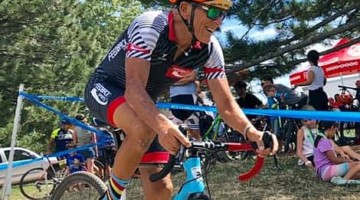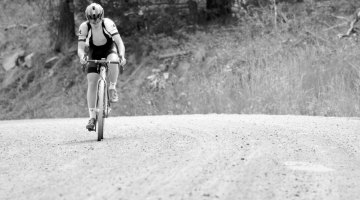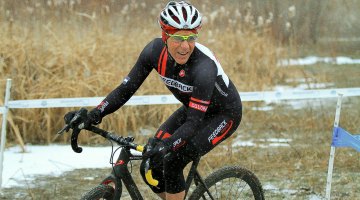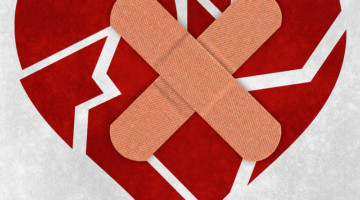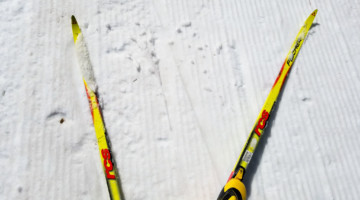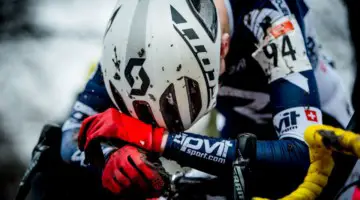
Lee Waldman already focusing on improving for next season © Annette Hayden, MountainMoon Photography.com
This week, Masters racer and Cyclocross Magazine columnist Lee Waldman offers some wisdom on his switch from roadie to cyclocrosser. If you missed it, be sure to check out Lee’s previous column about what motivates him, Transitions.
Over the past two seasons almost everything about my preparation for cyclocross has gone through a dramatic change. And so far every step I’ve taken has yielded positive results. Now, at 61 I know I’m faster and technically better than ever. That knowledge gives me a lot of confidence going into this season with my goal of a good showing in Louisville at Masters Worlds in January 2013.
It started for me when I realized that I could no longer maintain the mental and the physical motivation necessary to race a full season of road and then cyclocross. Starting on the road in March, then switching over to a ’cross schedule proved to be too much. My brain and my body rebelled. My wife was none too happy either. She pointed out, on more than one occasion, that bike racing was taking over all of my thinking. I needed to make some changes.
Step one: Cut back on my racing schedule. Race less. It wasn’t easy. I’d been racing on the road for almost 30 years. This was almost second order change for me. There were days when I felt like I was letting myself down, “babying out”. But, I noticed a distinct improvement in the consistency of my racing. Because I was focusing on ’cross I began the season fresher, more excited about racing, and didn’t suffer the burn-out half-way through the season that I had in the past.
Step two: Finding a coach. Just as with the change in my racing schedule, the results were positive. No more guessing about my workouts. No worrying over how to divide up the season for build, race, and taper periods. Someone with more knowledge did all of that for me. All I had to do was follow directions. I also had someone to answer to; even if it was only over email. All of a sudden it wasn’t as easy to simply decide I was too tired to do that set of intervals. If the plan was four hours on the bike – I did four hours on the bike. It’s amazing what accountability does for my motivation. More importantly, I took my rest days seriously. I raced better.
Step three: Riding the mountain bike. Incorporating both short track racing and endurance racing, although an unlikely combination, improved my attitude (the fun factor), my endurance (the vi ride factor), and my technique (the closeyoureyesandletthebikego factor). This year my results and my times in the longer races have improved dramatically. The more short track I race, the more aggressive competitive I become also.
Final step: Diet. This has been the big one this season! First, some background: This past summer my wife became one of my training heroes. You have to understand who she was when we first met to be blown away with who she is now. We met on line (another story in and of itself.) I had been seriously racing on the road for over 20 years. She exercised casually. We would hike together, ride a bit together, snowshoe a bit but she didn’t challenge herself and would stop when it got hard.
Two months ago she joined a woman’s exercise boot camp. Now, she’s an athlete in every sense of the word. Through her boot camp experience she introduced me to the concept of zone eating; a protocol where each meal and every snack is structured so that 40% of the calories are from carbs, 30% from protein and 30% from fat. This was new. I’d always followed the traditional thinking that, as an endurance athlete at least 60% of my calories needed to come from carbs, then protein and very little fat.
When you eat “in the zone”the theory is that your body relies less on carbs for energy and more on your fat stores. Fat, it seems, is a more readily available source of energy. There is more of it available to burn and the reduced level of carbohydrates in your system tends to keep your insulin levels from those drastic swings that I could never control.
According to the literature on zone eating, fat slows down the entry rate of carbohydrates into the system and decreases the production of insulin. Insulin makes you fat and therefore having more fat in the diet is important in reducing insulin since it doesn’t stimulate insulin production.
The body needs carbs at every meal but, when eaten in excess, there is an overproduction of insulin. The growing incidence of obesity in the US isn’t due to over-excessive fat consumption but increased consumption of carbs.
So, what do I do now? I eat a lot more than I ever did before – three meals following that balance of 40/30/30, and two snacks that have the same balance. I try not to go more than 2.5 hours without eating. I was skeptical at first but decided that I had nothing to loose by trying. In the past I’ve played with all different sorts of eating regimens and this one “couldn’t hurt”. I’ve always battled episodes of drastically reduced energy and what I always thought of as hypoglycemia. This was different.
The difference has truly been remarkable. I’m training the same if not harder than I was last year at this time yet my energy level, I was worried about fat gain. I was concerned about weight gain. I shouldn’t have. I’m leaner now than ever before, and faster.
How do I know? I’m climbing better, I can keep my heart rate elevated for longer. My results in my racing this year are improved from last year – and – I’m a year older.
I’ve tried to accurately represent the philosophy of the program. If I’ve made mistakes, I apologize. I’m a language arts teacher not a science teacher. But I can tell you that looking at your eating is one more incredibly important part of training for racing.
OK: Now, go grab a snack (40/30/30) and then – go ride!























